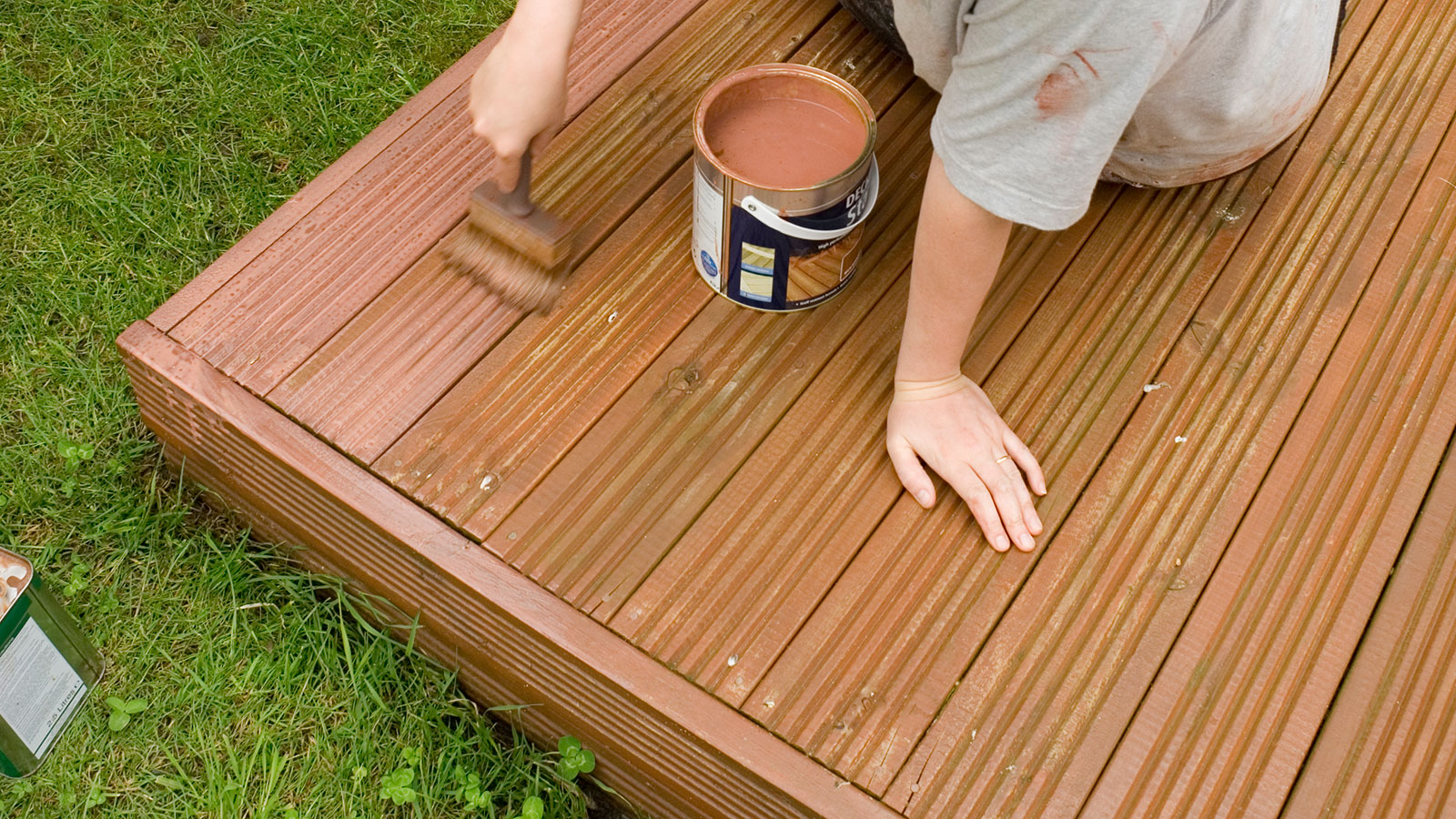Can you paint composite decking or is it just a waste of time?
Can you paint composite decking? We asked the experts for their views on whether this is a job worth doing or if your efforts might best be spent elsewhere in the garden this summer

Can you paint composite decking? While many people's thoughts might well be turning towards some deck maintenance now that summer is (almost) here, it really does pay to only carry out tasks that are going to really benefit your garden.
Decking ideas come in all shapes and sizes – and in many different materials too. The type of decking you have will dictate what kind of care and maintenance it requires to stay looking its very best – in short, what works for one decking material may well be completely unsuitable for another.
Here, we take a look at whether or not it is a good idea to paint composite decking, a material known for its durability.
Can you paint composite decking?
Despite the robust and relatively maintenance-free nature of composite decking, the UK weather inevitably means that any outdoor structure or surface is going to take something of a battering at times, leaving it looking a little less pristine than when it was first installed.
Decking maintenance is important for many reasons. Of course, all decking will benefit from being kept free of leaves and other debris, as well as a regular wash down with soapy water. However, in some cases a little more in the way of upkeep will be required – and in certain instances this can mean a fresh coat of paint. But is this a requirement for composite decking?
"Painting Trex composite decking is unnecessary," advises Lee Heitzman, Trex’s UK market manager. "Painting is a commitment to be kept up every few years, but the beauty of composite decking is how low maintenance it is – there’s no need to treat, stain, seal or paint it."
"There is no need to paint modern and high-quality decking because it is manufactured with a PVC cap or shell which protects it against damage and gives it its long life," explains Helen Godsiff, brand manager at Eurocell. "However, older and uncapped deck boards, which may have faded or changed colour over time, can normally be painted. Keep in mind that painting your composite decking may void your warranty."
Bring your dream home to life with expert advice, how to guides and design inspiration. Sign up for our newsletter and get two free tickets to a Homebuilding & Renovating Show near you.
"Painting composite decking is generally not recommended, but it can be done under certain conditions," further explains Chris Bonnett, the founder of Gardening Express. "If your decking is uncapped and more than ten years old it might be a little bit easier. This is because modern decking features a factory-applied finish that resists fading, staining, and scratching, making the decking more low maintenance and durable. But this also prevents the paint from adhering."

Chris founded Gardening Express in the late 1990's, while still a teenager. He decided it would be a fantastic idea to combine his passion of the great outdoors and plants with the Internet. While studying for a degree at Writtle College, world-renowned in the world of horticulture, Chris painstakingly built up the business, all funded from savings from part time jobs, until a full blown success had been created from the foundation years of hard work.
Can painting composite decking damage it?
While painting composite decking is, it seems, unnecessary, how about if you just fancy bringing in some new decking colour ideas? Could painting it be a good option or do you risk causing damage to your deck?
“We work hard to match the colours of our boards to true wood tones and textures and painting would disguise this natural wood look that so many clients ask for," explains Lee Heitzman. “Painting could potentially affect other benefits too including heat mitigating technology – our premium decking range reduces heat by up to 40% compared to traditional timber deck.”


Lee Heitzman is the UK market manager for Trex and has worked with builders' merchants and timber importers throughout his 22-year career.
Can uncapped decking be painted?
There are two types of composite decking: capped and uncapped.
"Uncapped decking, also known as first generation, doesn’t have a protective layer which means it is more prone to damage from the weather, sun, or general wear and tear. The colour can also fade faster. You can generally paint uncapped decking," says Helen Godsiff. "The surface of capped decking is coated in PVC which makes it suitable for use outdoors regardless of the weather. It also protects it against rotting, stains and fading, so you don't need to paint it. What’s more, if you do paint it, it’s likely to flake off.
"To find out if your decking is capped or uncapped, check the edge of the deck boards to see whether there is a thin layer on top," continues Helen. "Another clue is that it tends to be smoother, more vibrant and uniform in colour. If you’re unsure or have any doubts, check with your manufacturer or the product information booklet."
How do you paint composite decking?
If you have old, uncapped composite decking you might be keen to see whether a lick of paint could give it a new lease of life, but do be aware that this new coating may well not stand the test of time and you could expect your new composite decking ideas to quickly begin to deteriorate.
"It is very difficult to paint composite decking without it looking untidy and unprofessional," warns Lee Heitzman. "Over time, paint will also chip, flake and fade when exposed to the elements."
Still determined? "If the composite decking is old and faded and you do decide to give the decking a fresh coat of paint then there are a few things to consider," says Chris Bonnett. "Proper surface preparation is essential. The decking should be thoroughly cleaned to remove any mildew, mould, or debris.
"You should lightly sand the surface to improve paint adhesion and use a high-quality stain or exterior paint designed for composite decking – and don’t forget to apply a primer before painting."
"Painting your decking means committing to painting it every two to three years," explains Helen Godsiff. "You will also need to paint it meticulously to avoid it looking messy or uneven. Bear in mind that you will need suitable decking paint, which can be costly especially in the long run."
The range of decking paint from Frenchic adheres well to composie decking and comes in a wide range of colours.

Helen Godsiff is brand manager at Eurocell, a manufacturer, distributor, and recycler of building products. They recently invested £10m+ in their recycling plants due to their commitment to reduce the company's environmental impact.
FAQs
How can you keep composite decking looking good?
Just as with timber decking, to keep composite decking in good condition and looking its best for as long as possible, there is a degree of maintenance required, so be sure to familiarise yourself with how to clean decking properly.
"Taking care of your composite decking goes a long way to maintaining its colour. You only need to clean it once or twice a year, but regular sweeping can help prevent staining from leaves or debris, which can in turn prevent unsightly mould or mildew," says Helen Godsiff.
"If you do see surface stains, clean it with a soft bristled brush and washing up liquid. Cleaning can keep it looking fresh and in some cases, return it to a brand new state."
If you have a considerable build-up of dirt, try a product such as Wet & Forget Mould, Lichen & Algae Remover from Amazon.
How long should composite decking last?
According to Ultra Decking, providing you properly maintain and care for your composite decking, you can expect it to last for between 10-25 years.
If you are comparing wood decking vs composite, you might be interested to know that Ronseal advise that timber decking can lasts from between 15 and 30 years with the right care and maintenance. Alternatively, take a look at some decking alternatives if you're considering a change.
Both composite and timber decking are a fantastic way to create an outdoor area from which to sit and enjoy your garden. However, they are not the only option. There are some beautiful other patio design ideas to consider before making your final choice.
Natasha was Homebuilding & Renovating’s Associate Content Editor and was a member of the Homebuilding team for over two decades. In her role on Homebuilding & Renovating she imparted her knowledge on a wide range of renovation topics, from window condensation to renovating bathrooms, to removing walls and adding an extension. She continues to write for Homebuilding on these topics, and more. An experienced journalist and renovation expert, she also writes for a number of other homes titles, including Homes & Gardens and Ideal Homes. Over the years Natasha has renovated and carried out a side extension to a Victorian terrace. She is currently living in the rural Edwardian cottage she renovated and extended on a largely DIY basis, living on site for the duration of the project.

